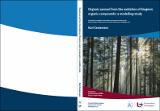Organic aerosol from the oxidation of biogenic organic compounds: a modelling study
| dc.contributor.author | Ceulemans, K. | |
| dc.date | 2014 | |
| dc.date.accessioned | 2020-08-25T18:31:52Z | |
| dc.date.available | 2020-08-25T18:31:52Z | |
| dc.identifier.uri | https://orfeo.belnet.be/handle/internal/7596 | |
| dc.description | Aerosols exert a strong influence on climate and air quality. The oxidation of biogenic volatile organic compounds leads to the formation of secondary organic aerosol (SOA), which makes up a large, but poorly quantified fraction of atmospheric aerosols. In this work, SOA formation from α- and β-pinene, two important biogenic species, is investigated through modelling. A detailed mechanism describing the complex gas phase chemistry of oxidation products is generated, based on theoretical results and structure activity relationships. SOA formation through the partitioning of oxidation products between the gas and aerosol phases is modelled with the help of estimated vapour pressures and activity coefficients. Given the large model uncertainties, validation against smog chamber experiments is essential. Extensive comparisons with available laboratory measurements show that the model is capable of predicting most SOA yields to within a factor of two for both α- and β-pinene. However, for dark ozonolysis experiments, the model largely overestimates the temperature dependence of the yields and largely underestimates their values above 30 ◦C, by up to a factor of ten. This model behaviour is improved when additional pathways towards non-volatile products are incorporated. Discrepancies are found between the observed and modelled SOA composition, as the model cannot explain the formation of several observed SOA tracers, and important model SOA species, such as hydroperoxides, await experimental identification. For β-pinene, uncertainties in key reactions in the newly implemented mechanism are shown to strongly impact ozone and SOA yields. Favouring the ring-opening of the main alkyl radical formed upon β-pinene OH-addition in the model is found to improve both ozone and SOA predictions. Products from bi-peroxy radicals formed in the ozonolysis of β-pinene are found to potentially contribute significantly to SOA. The model has been used to simulate the long-term photooxidation (ageing) of SOA formed in α-pinene chamber experiments. The model is found to overestimate aerosol concentrations upon SOA ageing by a factor of two or more in many cases, while modelled O/C ratios of aged SOA are also strongly overestimated. Possible causes for these discrepancies include missing gas phase or aerosol photochemistry, and the uncertain impact of wall losses. Finally, a simple parameterisation has been developed, suitable for use in large-scale models, and capable of reproducing SOA concentrations as simulated by the full model in various conditions. | |
| dc.language | eng | |
| dc.title | Organic aerosol from the oxidation of biogenic organic compounds: a modelling study | |
| dc.type | Thesis | |
| dc.subject.frascati | Earth and related Environmental sciences | |
| dc.audience | Scientific | |
| Orfeo.peerreviewed | No |

